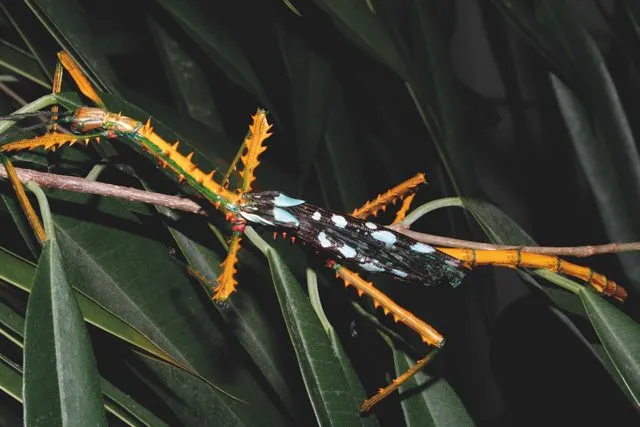1
Dicey dancing: Peacock spider
Jumping spiders are tiny, phenomenally athletic predators – some can leap over 20 times their body length. Australia has some particularly ostentatious species called peacock spiders, which deploy their nifty legwork to attract a mate.
Charismatic to the point of cuteness, these 5mm-long arachnids are fondly known as ‘kittens with legs’ by scientists studying their courtship displays. When a male peacock spider sees a potential partner, he takes up position in front of her and raises his third pair of legs. This unfurls a fan-shaped extension to his abdomen, revealing a shimmering pattern created by iridescent scales.
Now the male hops side-to-side and bops up and down to show off his velvety technicolour dreamcoat. He also alternately waves his white-tipped legs, as a kind of spider semaphore. It’s a dangerous display, however, since the would-be dad dancer risks becoming the female’s post-coital meal.
2
Toxic toads: Purple harlequin toad
Rushing mountain streams in Central and South America are home to the exceptionally flashy harlequin toads, which stand out like a sore thumb in neon purple, green, blue, orange and yellow.
These striking patterns, called ‘aposematic colouration’, are designed to put predators off their dinner. Put simply, it’s a ‘don’t eat me’ warning: the toads make a deadly mouthful, as toxins produced by their skin and neck glands rank among the most potent natural poisons yet discovered.
Amphibian neurotoxins can easily kill a human, something long known by Amazonian peoples who use them in various (occasionally fatal) rituals, and for hunting. But there is also growing interest from medical science in these secretions, as they could hold the key to creating a new generation of drugs for treating cancer, heart disease and perhaps many other conditions.
See more about weird and wonderful animals:
- Eight of nature’s grooviest dancing animals
- Flying animals: 7 animals that actually fly (but really shouldn’t)
- Animals' mating rituals: 5 weird ways animal hook up
3
Frilled to meet you: Frilled lizard
This dragon-like reptile from the Australian Outback has one of the largest visual displays (compared to body size) in the animal kingdom. A fully-grown frilled lizard can reach one metre from chin to tail-tip.
When threatened, it flicks open an orange, Dracula-esque frill up to 30 centimetres across, which normally lies flat around its shoulders. The skin is stretched over several rod-shaped bones connected to the hyoid, or tongue bone, and if the lizard opens its jaws suddenly, these bones splay out, pulling the skin taut and erecting the frill; the wider the gape, the bigger the display. The animal hisses loudly for good measure, too.
But it’s all bluff: the frilled lizard is in truth a shy insect-eater that spends most of its time hiding up eucalyptus trees. Should its deterrent fail, the lizard legs it, rearing up on strong hindlimbs in a bipedal sprint like a miniature Velociraptor.
Defensive displays that rely on startling or confusing a predator are known as ‘deimatic’, but male frilled lizards also use their fancy headgear in aggressive encounters with their own kind. In 2013, researchers reported that males with the brightest orange frills were far more likely to dominate paler rivals, winning 90 per cent of fights.
4
Rattle and strum: Lowland streaked tenrec
Evolution runs riot on islands, a fact of life elegantly demonstrated by Madagascar’s tenrecs. Having reached the then mammal-free paradise many millennia ago, their single ancient ancestor did as the marsupials of Australia did, and developed into a fabulous array of oddballs reminiscent of shrews, moles, mice, rats and hedgehogs.
The streaked tenrec is the family extrovert, scurrying around lowland rainforest with the flexible, earthworm-sniffing snout of a shrew and the defensive chutzpah of a porcupine – those wickedly barbed spines (actually modified hairs) will detach when flicked, impaling a predator.
But this tenrec has a hidden talent that elevates it into the wildlife show-off premier league. By vibrating its neck quills, the creature produces high-pitched ultrasound. This ‘stridulation’ is common among crickets, grasshoppers and beetles, yet no other mammals communicate this way. Madagascar mammal expert Nick Garbutt likens the sound to “dry grass being rubbed together”, arguably underselling what is surely one of the weirdest calls of nature.
5
Sea change: Flamboyant cuttlefish
Like octopuses, cuttlefish can switch colour, shape and texture at will. These creatures have phenomenally acute vision and may even possess a sense of self, claimed Prof Peter Godfrey-Smith in a recent book about the cephalopods (the class of marine molluscs to which cuttlefish and octopuses belong).
Since their skin is packed with chromatophores – elastic, pigment-rich cells wired up to their nervous system – they are able to change colour and pattern rapidly. They can also send repeated waves of intense, pulsating colour over their body, like a light show in a nightclub.
Listen to the Science Focus Podcast:
- Could leaving nature to its own devices be the key to meeting the UK’s climate goals? – Mark Lynas
- Are we facing an insect apocalypse? – Brad Lister
- The genetic hunt for the Loch Ness Monster – Neil Gemmell
Cuttlefish probably first evolved this extreme body-morphing ability as camouflage, then later began using it to startle or confuse predators while making good their escape.
Species such as the tropical Indo-Pacific ‘flamboyant cuttlefish’ also deploy spectacular effects during their courtship. It’s one of the most mesmerising and mysterious forms of visual communication in the animal kingdom.
6
Labour of love: Flame bowerbird
Can animals produce art? Though their craftsmanship is instinctive, the bowerbirds of New Guinea and Australia come pretty close.
Adult male bowerbirds devote enormous amounts of time and energy to building complex constructions of sticks and leaves on the rainforest floor, often featuring elaborate symmetry and tricks of perspective. These bowers serve as arenas for luring passing females.
When complete, the avian architects decorate their creations with eye-catching trophies gathered from the forest – colourful berries and flowers, glittering beetle wing cases, empty shells or pieces of bleached bone. Yet the task is never-ending: a bower needs hours of daily maintenance, to ensure that any stray twig or leaf is put back in its correct position.
Each species of bowerbird includes its own signature design features: the flame bowerbird, for example, adds a fresh coat of mud ‘paint’ every day. Such is the effort involved that the quality of a bower is a fairly good guide to the fitness of the bird that built it. And since females tour numerous bowers, it appears that they are weighing up the males’ relative merits – are they the bird world’s art critics?
7
Sticking out: Achrioptera maroloko

The world’s 3,000 species of stick insect, most of which inhabit tropical forests, have perfected the disappearing act. Some even incorporate imitation leaf buds in their camouflage, or mimic snapped-off twigs and damaged foliage.
As is so often the case in nature, the group has a few nonconformists. Two recently discovered giant stick insects from Madagascar have retained the archetypal spindly silhouette, but have traded cryptic colouration for flamboyance. Intriguingly, they are dull-hued when young, only developing their bling at sexual maturity.
Scientists speculate that their gaudy adult appearance may help win a mate, or perhaps they absorb and accumulate toxins from leaves while feeding, and are advertising their foul taste to hungry birds. Either way, these stick insects are exhibitionists that play against type.
- This is an extract from the Autumn 2019issue ofBBC Science Focus–subscribe here.
Follow Science Focus onTwitter,Facebook, Instagramand Flipboard
